Mechanism and Application of Static Stress Intervention for Controlled Directional Roof Caving in Fully Mechanized Mining Faces
Abstract
1. Introduction
2. Project Overview
3. Mechanism of Static Stress Intervention in Roof Cutting
4. Analysis of Roof–Rock Pressure Under Static Stress Intervention
4.1. Numerical Simulation Model
4.2. Roof Mining Pressure Distribution Pattern
5. On-Site Application and Effect Analysis
6. Conclusions
Author Contributions
Funding
Data Availability Statement
Conflicts of Interest
References
- Li, X.; Liu, S.; Fu, M.; Peng, B.; He, Y. Research and application of influencing factors of key parameters of roof cutting and pressure relief by dense drilling. Coal Sci. Technol. 2023, 51, 243–253. [Google Scholar]
- Ma, J.Q.; Li, X.H.; Yao, Q.L.; Xia, Z.; Xu, Q.; Shan, C.H.; Sidorenko, A.; Aparin, A. Numerical simulation on mechanisms of dense drilling for weakening roofs and its application in roof control. J. Cent. South Univ. 2023, 30, 1865–1886. [Google Scholar] [CrossRef]
- Zhang, B.; Wang, P.; Cui, S.; Fan, M.; Qiu, Y. Mechanism and surrounding rock control of roadway driving along gob in shallow-buried, large mining height and small coal pillars by roof cutting. J. China Coal Soc. 2021, 46, 2254–2267. [Google Scholar]
- Wang, M.; Zheng, H.; Ma, Z.; Mu, H.; Feng, X. Control Technology of Roof-Cutting and Pressure Relief for Roadway Excavation with Strong Mining Small Coal Pillar. Sustainability 2023, 15, 2046. [Google Scholar] [CrossRef]
- Zhang, K.; Liu, C.; Zhang, H.; Yue, X.; Liu, H. Research on Roof Cutting Pressure Relief of the Gob-Side Entry Retaining With Roadside Backfilling. Front. Earth Sci. 2022, 10, 835497. [Google Scholar] [CrossRef]
- Feng, G.; Fan, Y.; Wang, P.; Guo, J.; Gao, R.; Wen, X.; Zhang, P.; Zhu, L.; Qian, R.; Zhang, J. Fracture propagation law of hydraulic fracturing of rock-like materials based on discrete element method. J. China Coal Soc. 2024, 49, 2231–2246. [Google Scholar]
- Zhang, H.; Liu, C.; Chen, Z.; Yu, X.; Zhang, K.; Liu, H. Analysis and Application of Hydraulic Fracturing to Control Hard and Stable Roof in Initial Mining Stage. Sustainability 2023, 15, 10518. [Google Scholar] [CrossRef]
- Cheng, L.; Zhang, Z.; Jiang, P.; Yang, J. Research and application of stress field response mechanism based on roof hydraulic fracturing pressure relief. J. Min. Saf. Eng. 2023, 40, 722–729. [Google Scholar]
- Tai, Y.; Yu, B.; Xia, B.; Li, Z.; Xia, H. Research on stress release for the gob-side roadway using the roof-cutting technology with a chainsaw arm. R. Soc. Open Sci. 2020, 7, 191663. [Google Scholar] [CrossRef]
- Feng, S.; Chen, X.; Wang, L.; Li, L.; Li, X. Air Flow Movement Law in Working Face and Gob with Roof-Cutting and Pressure-Releasing Mining: A Numerical Simulation and Engineering Verification. ACS Omega 2023, 8, 25960–25971. [Google Scholar] [CrossRef]
- Li, S.; Li, Z.J.; Luo, M.K. Experimental Study on Reasonable Composition and Proportion of Coal and Rock Static Cracking Agent. Blasting 2018, 35, 137–141+153. [Google Scholar]
- Huang, H. Application and Research of Static Broken Used in High-Gas Coal Mine Roadway End Caving Roof Control; Taiyuan University of Technology: Taiyuan, China, 2014. [Google Scholar]
- Huang, X.P. Research on Optimization of Static Roof Cutting and Stress Releasing Parameters at the Side of Mining Roadway; Taiyuan University of Technology: Taiyuan, China, 2018. [Google Scholar]
- Wang, F.Q.; Li, Z.X.; Wu, J.; Gao, C.; Wang, J.N.; Ren, X.Y.; Ma, X.C.; Zhang, T. Study on Static Expansion and Roof Cutting Technology at End of Large Mining Height Working Face. Coal Technol. 2023, 42, 95–99. [Google Scholar]
- Hao, B.Y.; Li, Z.H.; Huang, H.; Zhao, G.L. Research and Application of Static Crushing Technology Handled Roadway Roof Overhang in High-gas Coal Mine. Blasting 2015, 32, 109–114. [Google Scholar]
- Xiang, H.T.; Yan, G.C.; Ding, H.Q.; Kou, K.B.; Li, G. Research and Application of Static Precrack Technology of Roof Before Initial Mining in High Gas Mine. Min. Res. Dev. 2022, 42, 14–19. [Google Scholar]
- Ding, H.; Yan, G.; Kou, K.; Dong, J.; Xiang, H. Study on the technology of roof cracking caused by static crushing agent inXiaochang Coal Industry. Min. Saf. Environ. Prot. 2023, 50, 100–104+110. [Google Scholar]
- Vu, T.T.; Do, S.A. Determination of the rock mass displacement zone by numerical modeling method when exploiting the longwall at the Nui Beo Coal Mine, Vietnam. Min. Miner. Depos. 2023, 17, 59–66. [Google Scholar] [CrossRef]
- Dmytro, B.; Olena, S.; Hapieiev, S.; Prykhodchenko, V. Multifactorial analysis of a gateroad stability at goaf interface during longwall coal mining—A case study. Min. Miner. Depos. 2023, 17, 9–19. [Google Scholar]
- Yang, X.; Yang, G.; Huang, R.; Wang, Y.; Liu, J.; Zhang, J.; Hou, S. Comprehensive study on surrounding rock failure characteristics of longwall roadway and control techniques. Appl. Sci. 2021, 11, 9795. [Google Scholar] [CrossRef]
- Li, P.; Yang, C.; Fu, X.; Li, J.; Jin, D. Reinforcement of Insufficient Transverse Connectivity in Prestressed Concrete Box Girder Bridges Using Concrete-Filled Steel Tube Trusses and Diaphragms: A Comparative Study. Buildings 2024, 14, 2466. [Google Scholar] [CrossRef]
- Hou, C.J.; Ma, N.J. Stress in in-seam roadway sides and limit equilibrium zone. J. China Coal Soc. 1989, 14, 21–29. [Google Scholar]
- Huang, W.P.; Gao, Y.B.; Wen, Z.J.; Gao, L. Technology of gob-side entry retaining using concrete-filled steel tubular column as roadside supporting. J. China Univ. Min. Technol. 2015, 44, 604–611. [Google Scholar]
- He, M.C.; Gao, Y.B.; Yang, J.; Guo, Z.B.; Wang, E.Y.; Wang, Y.J. The energy-gathered roof cutting technique in non-pillar mining and its impact on stress evolution of surrounding rocks. Chin. J. Rock Mech. Eng. 2017, 36, 1314–1325. [Google Scholar]
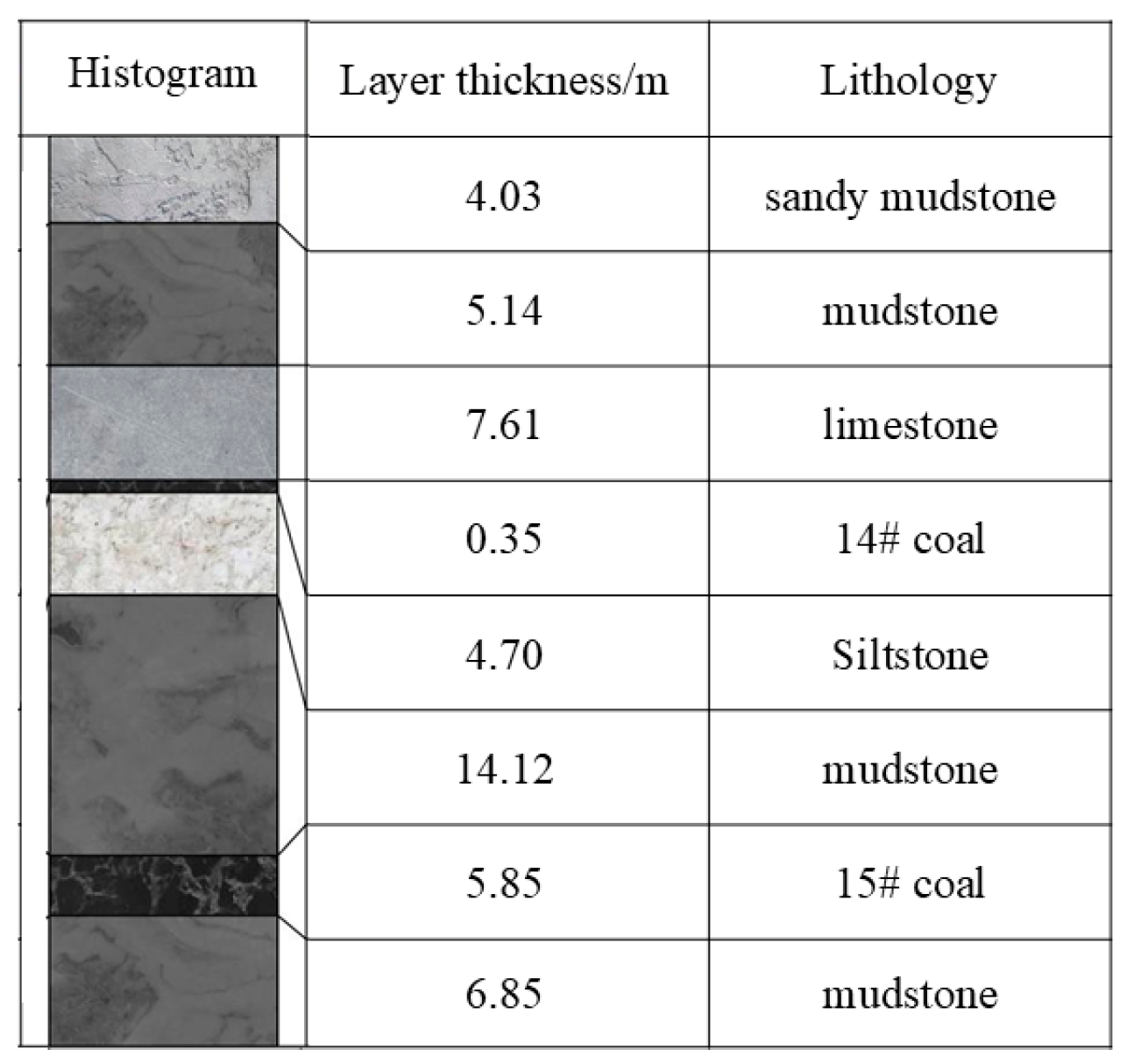
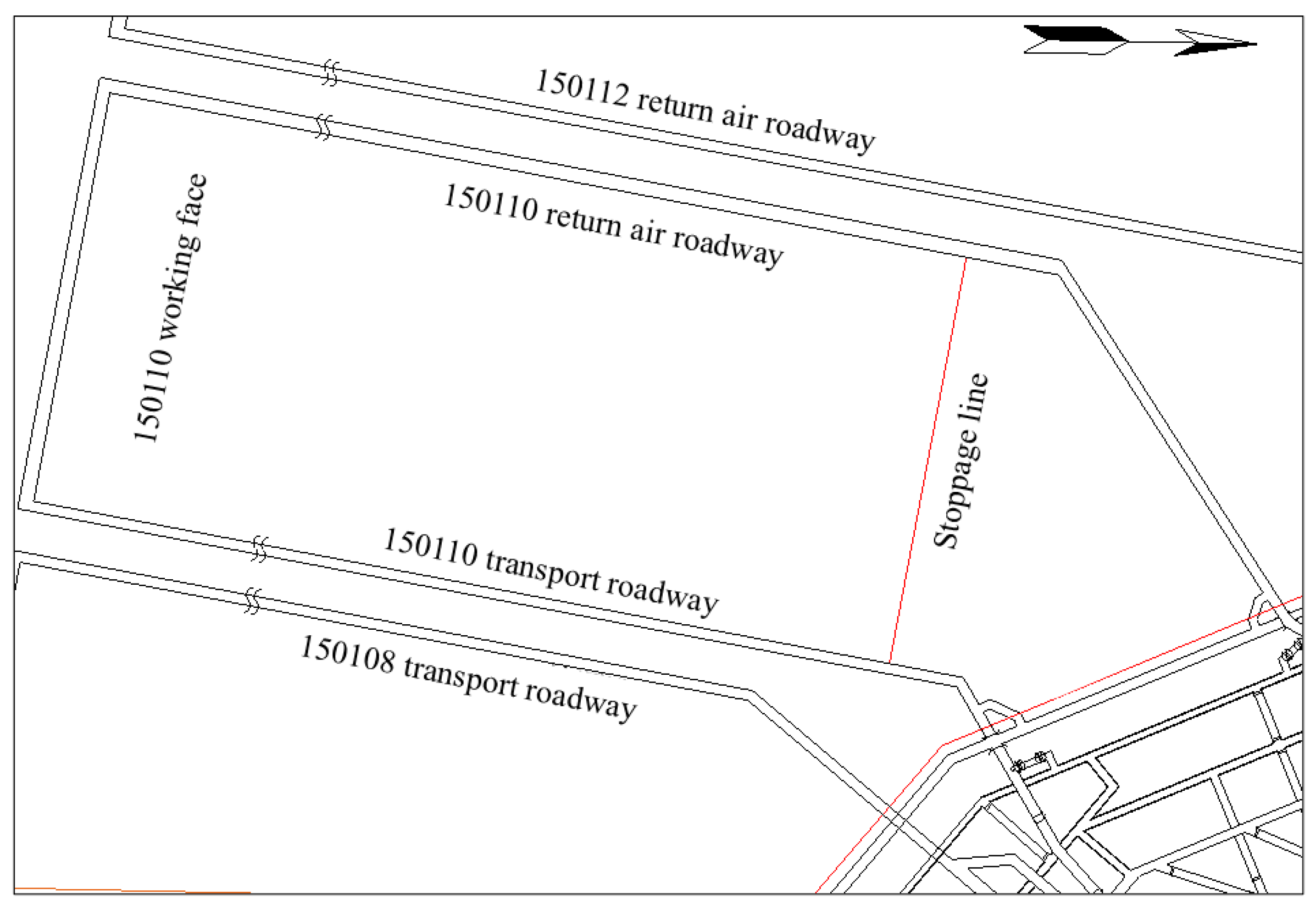


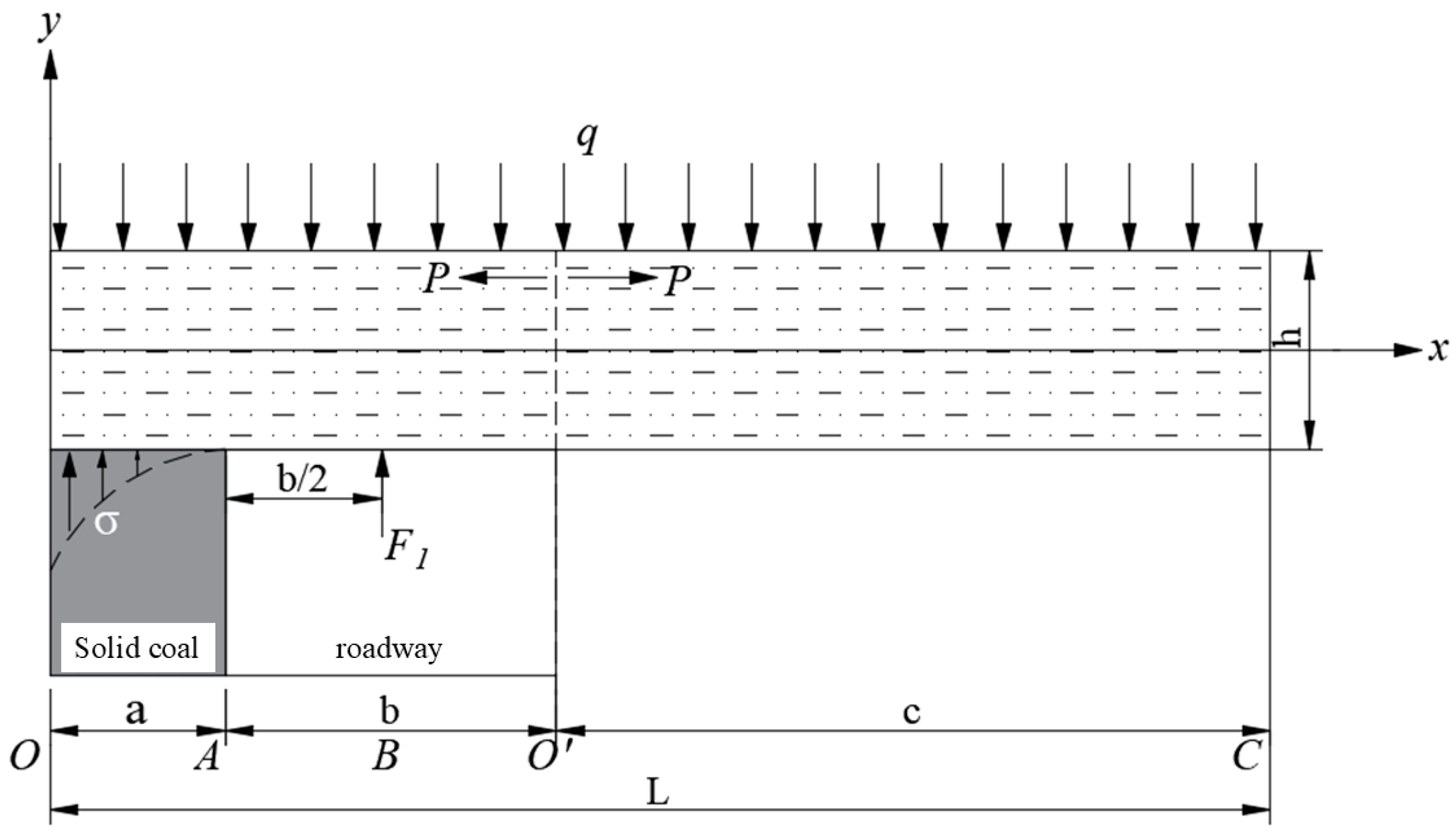
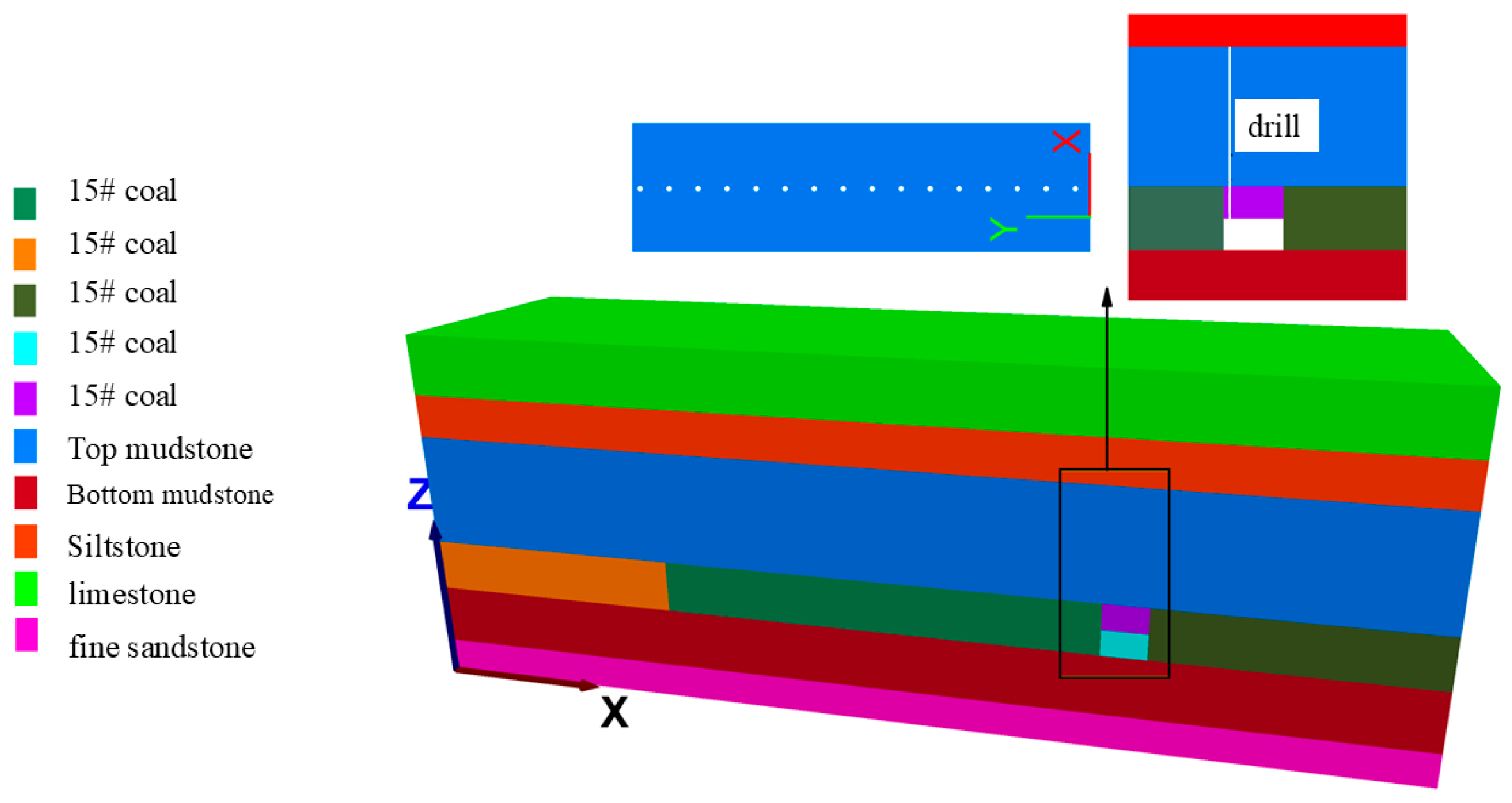

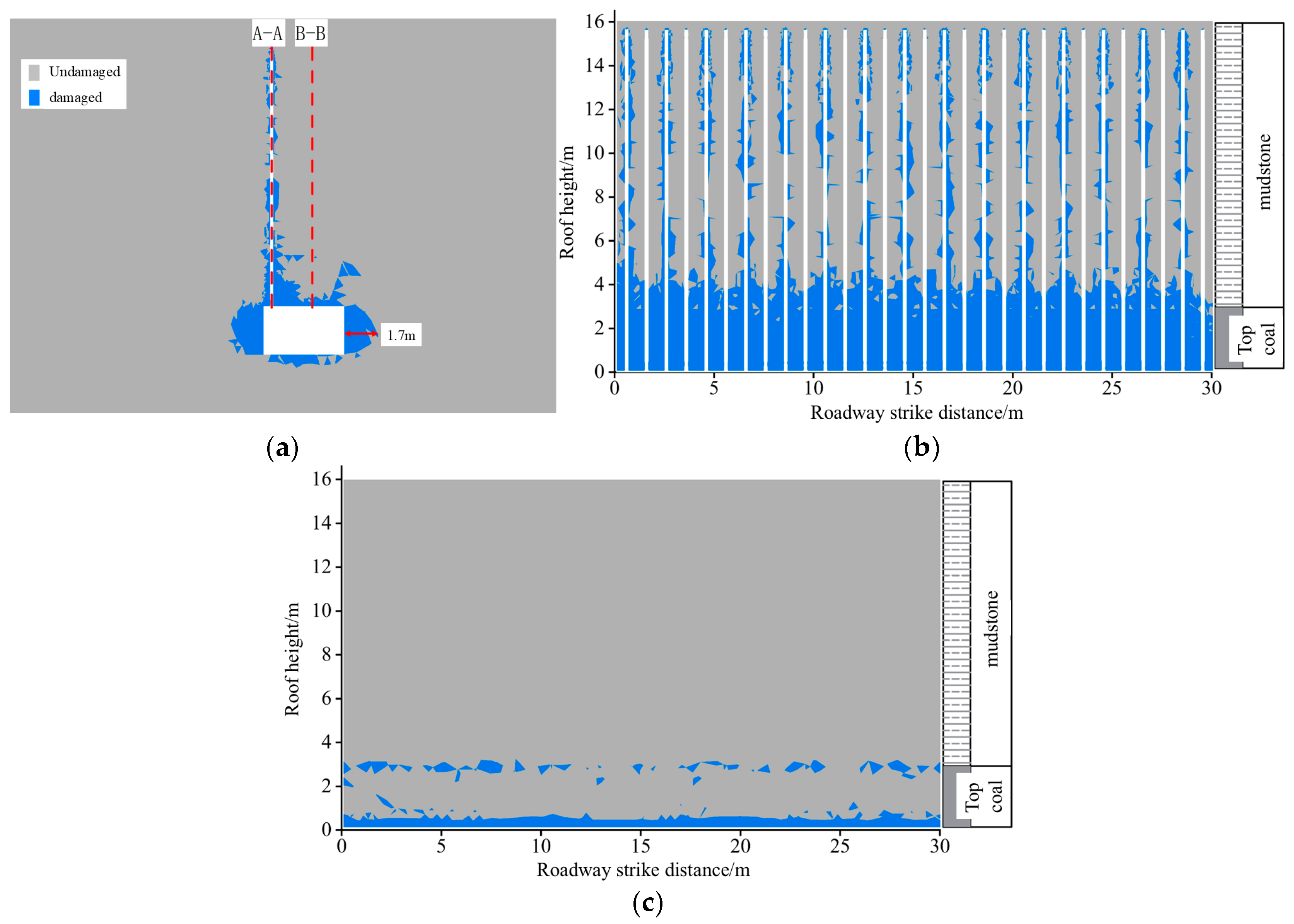

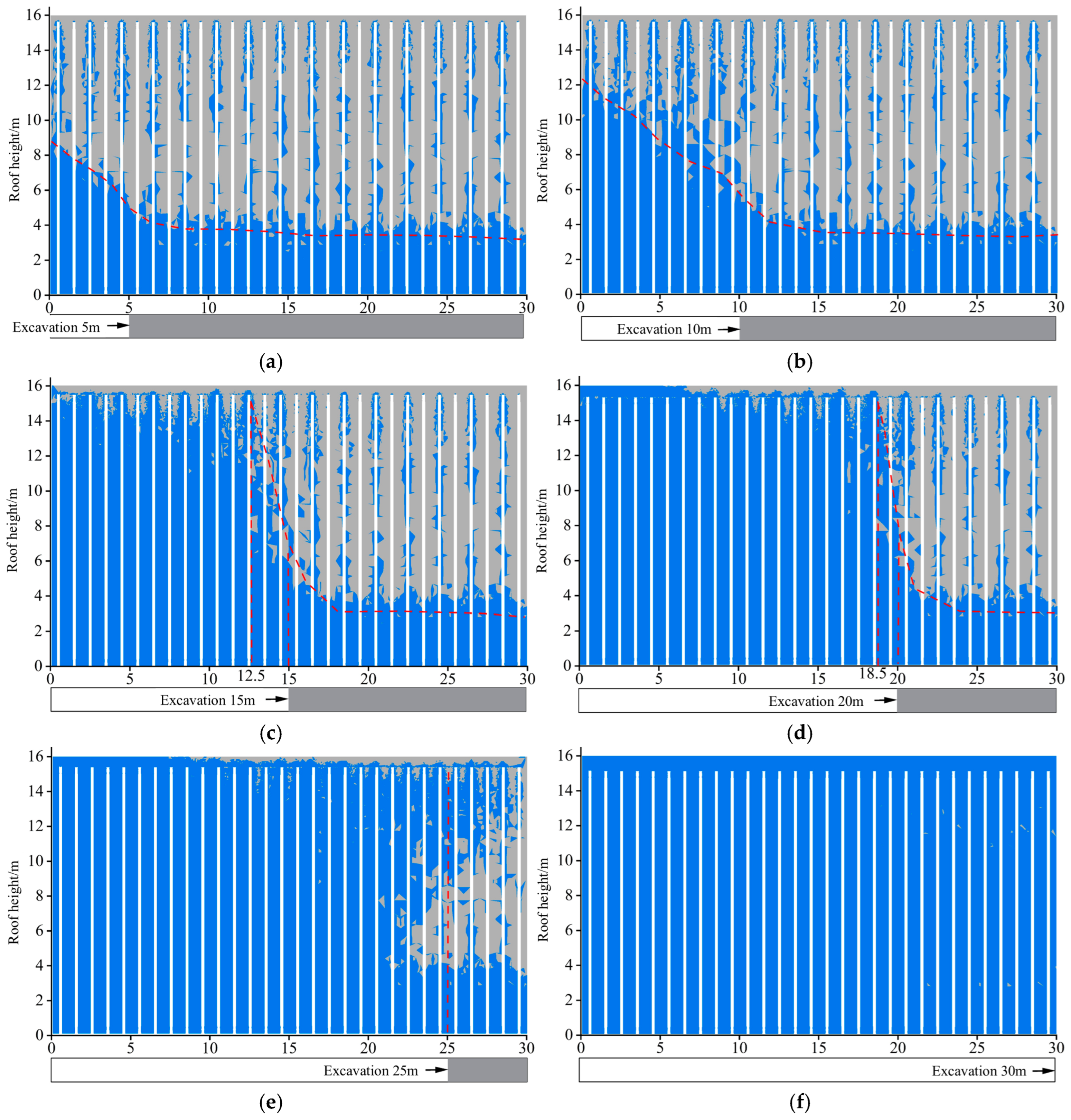


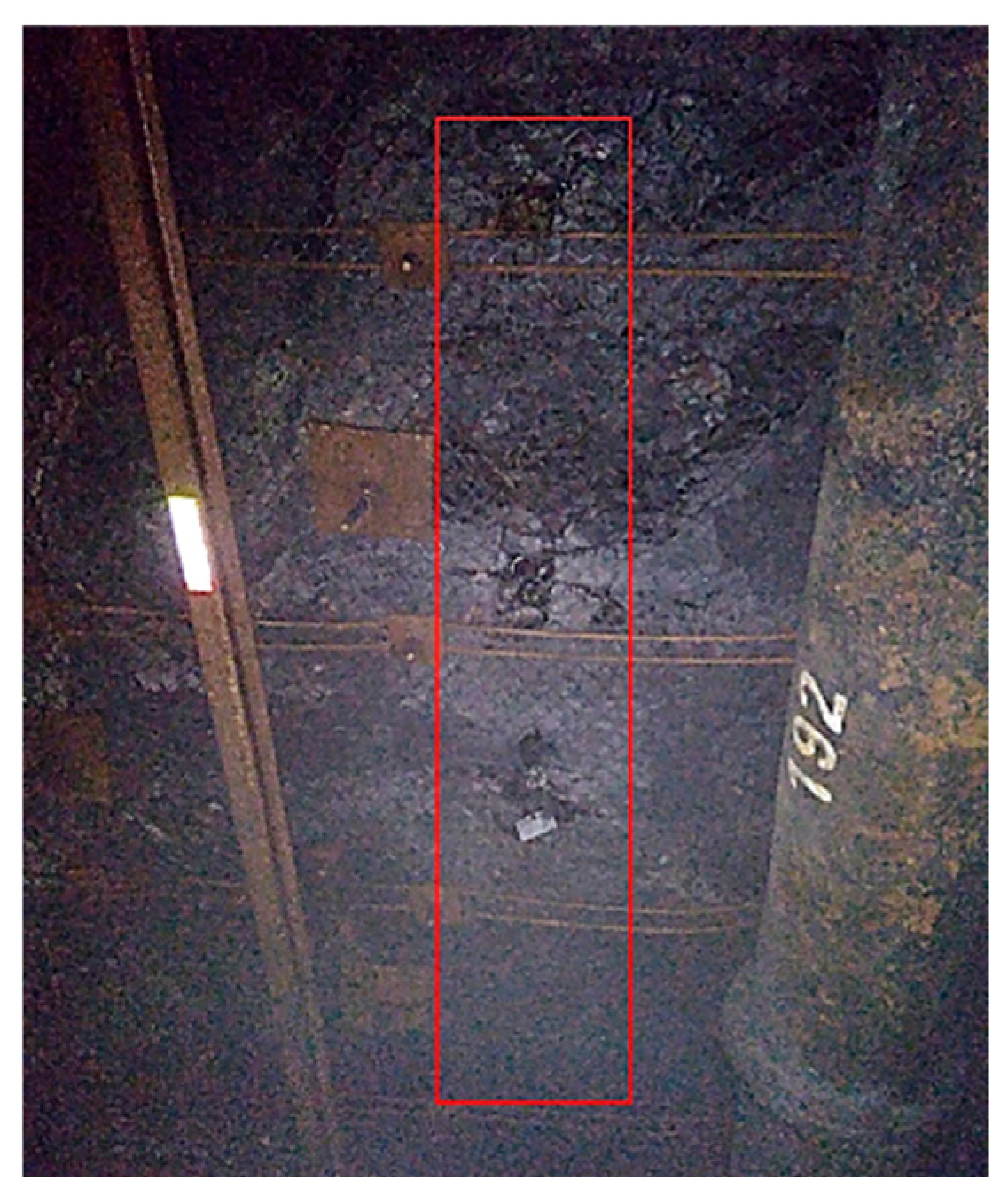
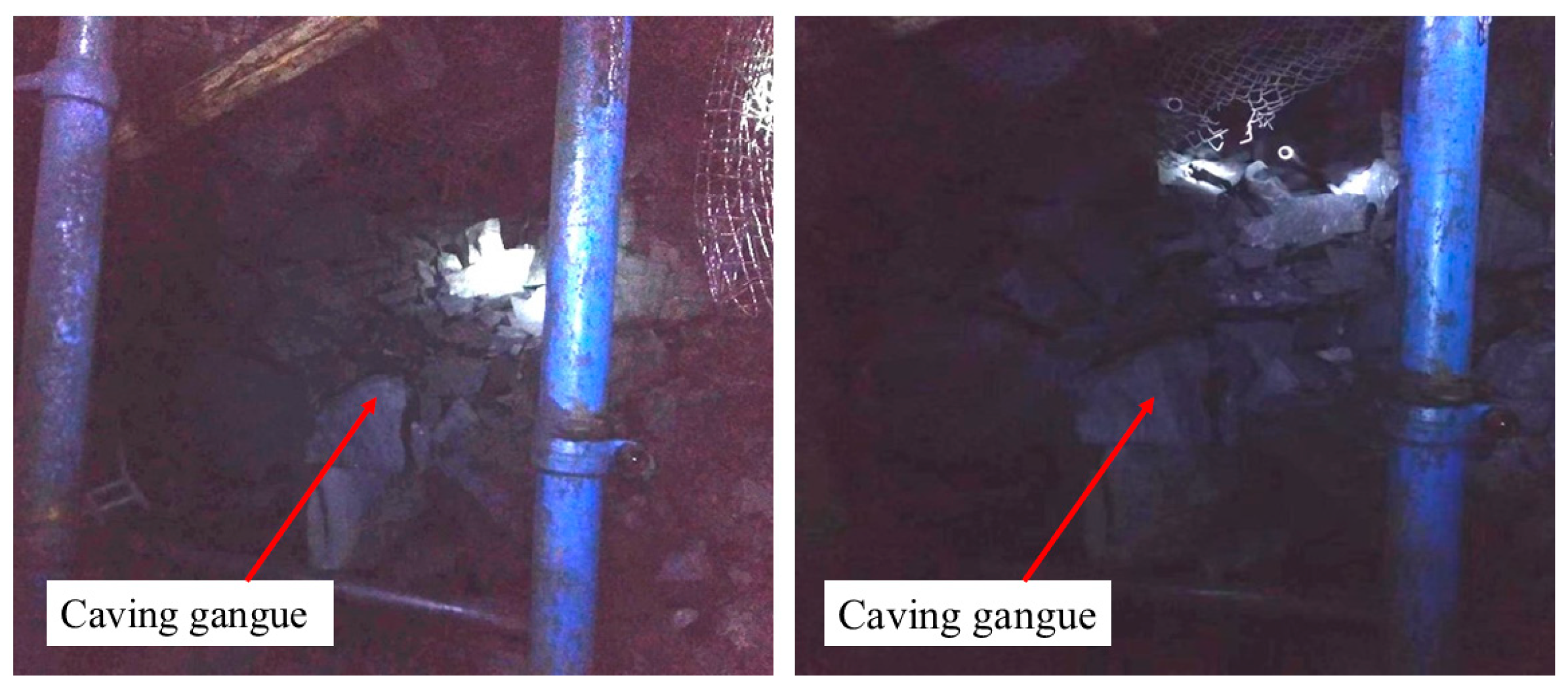
| Lithologic | Density /(g/cm−3) | Bulk Modulus /GPa | Shear Modulus /GPa | Cohesion /MPa | Internal Friction Angle/(°) | Tensile Strength /MPa |
|---|---|---|---|---|---|---|
| Limestone | 2.89 | 4.57 | 3.53 | 4.92 | 36 | 2.13 |
| Siltstone | 2.46 | 9.1 | 5.0 | 2.75 | 38 | 1.84 |
| Mudstone | 2.61 | 5.08 | 2.47 | 3.7 | 30 | 0.44 |
| 15# coal | 1.4 | 0.85 | 0.38 | 1.0 | 28 | 0.5 |
| Mudstone | 2.61 | 5.08 | 2.47 | 3.7 | 30 | 0.44 |
| Fine sandstone | 2.64 | 4.0 | 2.7 | 3.8 | 35 | 1.97 |
Disclaimer/Publisher’s Note: The statements, opinions and data contained in all publications are solely those of the individual author(s) and contributor(s) and not of MDPI and/or the editor(s). MDPI and/or the editor(s) disclaim responsibility for any injury to people or property resulting from any ideas, methods, instructions or products referred to in the content. |
© 2025 by the authors. Licensee MDPI, Basel, Switzerland. This article is an open access article distributed under the terms and conditions of the Creative Commons Attribution (CC BY) license (https://creativecommons.org/licenses/by/4.0/).
Share and Cite
Shi, H.; Hao, B.; Ren, X.; Zhang, J. Mechanism and Application of Static Stress Intervention for Controlled Directional Roof Caving in Fully Mechanized Mining Faces. Processes 2025, 13, 1552. https://doi.org/10.3390/pr13051552
Shi H, Hao B, Ren X, Zhang J. Mechanism and Application of Static Stress Intervention for Controlled Directional Roof Caving in Fully Mechanized Mining Faces. Processes. 2025; 13(5):1552. https://doi.org/10.3390/pr13051552
Chicago/Turabian StyleShi, Hao, Bingyuan Hao, Xingyun Ren, and Ji Zhang. 2025. "Mechanism and Application of Static Stress Intervention for Controlled Directional Roof Caving in Fully Mechanized Mining Faces" Processes 13, no. 5: 1552. https://doi.org/10.3390/pr13051552
APA StyleShi, H., Hao, B., Ren, X., & Zhang, J. (2025). Mechanism and Application of Static Stress Intervention for Controlled Directional Roof Caving in Fully Mechanized Mining Faces. Processes, 13(5), 1552. https://doi.org/10.3390/pr13051552






